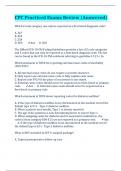Exam (elaborations)
MIP1502 Assignment 2 (QUALITY ANSWERS) 2024
- Course
- Institution
- Book
This document contains workings, explanations and solutions to the MIP1502 Assignment 2 (QUALITY ANSWERS) 2024. For assistance call or us on 0.6.8..8.1.2..0.9.3.4........ Question 1 1.1 Discuss why mathematics teachers in primary school must be concerned with the concept of equality as soon learn...
[Show more]












